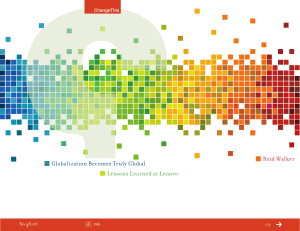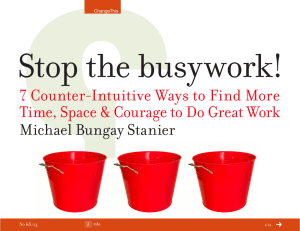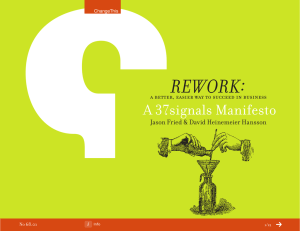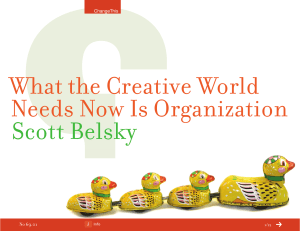The Business Genome Approach ® Finding Your Next Competitive Advantage | Andrea Kates
advertisement
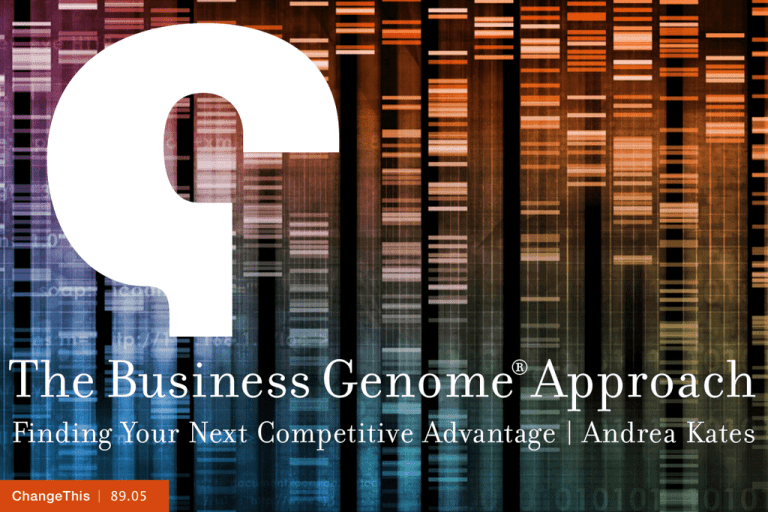
The Business Genome® Approach Finding Your Next Competitive Advantage | Andrea Kates ChangeThis | 89.05 You have the wrong tools. And you use them the wrong way. It isn’t your fault. You were taught, as we all were, to make forecast models out of past results. You were taught to look in the rear-view mirror. You were also taught to look straight ahead of you. If that competitor was in your line of sight, you had their number. That’s how you knew you were staying ahead. They were good people that taught you these skills, great professors of the craft in business school, veteran managers and executives in your first, third, and twentieth job. But that was a different time. That was when we could see the future by looking back. Somehow, it made sense back then. But, now, the rules have changed: our game plans have gone public, and whoever knows what the customer will do next wins (Borders has—had—nothing on Amazon). Now, it’s all about knowing tomorrow’s news today. And who tomorrow’s competitors will be. And what tomorrow’s customers will want. It’s a life-or-death world out there. And we don’t have the luxury to play catch up. ChangeThis | 89.05 But how do we do it? How do we see? You need a tool that will enable you to look further forward and further out. You need a periscope. For business. If Napoleon, armed only with the training of regiments and the mastery of bayonets, was asked to step up to the challenge of today’s world of warfare, he’d fail. He couldn’t possibly create battle plans for a large-scale international war, or devise an effective response to random acts of terrorism, or develop a successful strategy for Internet-based security breaches. Not with nothing more innovative than a few thousand armed foot soldiers. “ You need a tool that will enable you to look further forward and further out. But business leaders, equipped with strategies from the pre-Internet, pre-globalization days are asked to do exactly that—fight in a competitive world against new systems of attack. The challenge is formidable. One, we face expectations of double-digit growth during times of increasing economic pressure; two, the ever-accelerating pace of change amplifies the impact of every bad decision; and three, the transparency of the marketplace renders all of us completely naked. ChangeThis | 89.05 Late eighteenth century and early nineteenth century strategies served us well until advances in weaponry entered the scene. But those same blueprints for battle couldn’t keep pace with the new mentality of military engagement, one that demanded everything from nuclear weapons and drones to guerilla warfare. With nuanced threats perpetrating themselves on the Web and sophisticated algorithms for infiltrating security files, a man with a gun would hardly stand a chance. If Napoleon were to command an army today, he’d exchange his bayonets for droids. If that army were a business, he’d want to master the use of a periscope, not a telescope, and certainly not a microscope. The right sight is power. “ We can’t win in today’s business world with yesterday’s tools and strategies. The same is true for business. We can’t expect to achieve significant growth with traditional strategic plans based on steady expansion of our customer base and market share that automatically builds without the serious exercise of a new set of muscles—the set of corporate capabilities that is trained to respond nimbly to changing market conditions and geared toward rapid innovation to stay ahead of competitors. ChangeThis | 89.05 We can’t win in today’s business world with yesterday’s tools and strategies. They worked then, but they don’t work now. We live in a world of speed and transparency. Toss out those strategic plans and equip yourself with what you need: foresight and a shield. Our competitors now emerge on the scene in an instant, blindsiding those of us whose five-year plans didn’t prepare us for what was about to hit them. Remember Groupon and its meteoric entrance that shocked what had previously been a staid world of coupons and daily discounts offered by local merchants. The coupon innovator slipped in quietly, and in less than two years landed $500 million of transactions in a new competitive arena. Gone also are the days when your walls acted as a one-way membrane to filter your messages to customers through, in effect controlling a conversation that had your brands as the primary topic. Communication is naked, and fast. Starbucks CEO Howard Schultz explains how he came to this realization: Four months earlier, in November 2006, Google bought YouTube for a reported $1.2 billion in stock. And five months earlier, a website called Facebook officially invited anyone over age 13—not just select groups—to join its social network. The times were changing, with or without Starbucks. I knew we could no longer tell our story only in our stores. —Howard Schultz, author of Onward ChangeThis | 89.05 We are more exposed to our customers and our employees than we ever have been before. Everyone can see our four P’s (product, price, promotion and place) and compare them with others, and they can talk about us with the click of a button. Our own employees can spread the secrets of our workplace culture amongst themselves and anyone who might have been a prospective employee. For better or for worse, word travels fast. And we want those words to be positive, so we have to be careful. So now what? That was then. This is now. And we need to discover what’s next … Innovation comes from being creative. And that means looking elsewhere for inspiration. You have to get clever. You have to think outside of yourself, outside of your industry. Look around you. Look past you. Step up your surveillance of other companies for underlying adjacencies. Who’s servicing your customers with new stuff, and what are they selling? Who’s selling products that complement yours? What is everyone doing? What aren’t you doing? Once you’ve done that, you’re getting somewhere. But then, you need to get to work, and borrow, and graft. You need to hybridize yourself. You can’t afford to wait. You won’t survive on incremental growth. ChangeThis | 89.05 Close customer relationships, or better information or stuff, is no longer enough to keep you ahead or even afloat. The secrets of your “secret sauce” can be discovered by anyone anywhere and word can spread fast. What the new realities have done is put us all on even ground. Our competitors can arm themselves with the same information we can arm ourselves with. They can crack the code on what the public needs before we get a chance to figure it out. We have to act fast, and creatively. “ Innovation comes from being creative. And that means looking elsewhere for inspiration. You have to get clever. You have to think outside yourself, outside your industry. You need to master the art and science of crossing industry for brilliance, insight, and opportunity—even survival. And the periscope is your key to this, the key to “your next.” Why a periscope? Because it enables you to look past your own point of view, and allows you to see what’s on the horizon in plain view right now. Before long, you’ll have widened your field of vision and found fresh insight. ChangeThis | 89.05 Pennzoil used its periscope to see not only what ExxonMobil was doing for its next, but to peer across the industry fence towards Starbucks. What it saw was the coffeemaker’s great “hangingout” atmosphere and used it to create the Jiffy Lube experience—replacing what had been an unpleasant vibe, the mechanic’s garage, with a comfortable, WiFi-enabled lounge. Herwig Maes did this at Johnson & Johnson when he studied companies like Nike and Black and Decker. He, as one of its executives in transportation, looked to Nike to get up to speed in barge transit. The sporting goods retailer had mastered the European waterways, and even though their products and industries were vastly different, Maes and his team could learn something from them about shipping. He looked to Black and Decker and how they warehoused power tools and spare parts for just-in-time delivery and copied that approach for Johnson & Johnson’s global distribution of surgical supplies. As a result of these changes and others, the megaproducer set a new standard in sourcing and supplies management. Going back to the military analogy, Kaiser Wilhelm II did this when he reinvented German military logistics after observing the lightning-speed Ringling Circus quickly unload and reload its trains to set up its massive campsites on its European tour. ChangeThis | 89.05 Is it time for you to pull out your periscope? Do any of these scenarios sound familiar to you? 1. Customer scores are high, but sales are sluggish. 2. Businesses that do something like what you do are branching out (like Blockbuster and Netflix). 3. People aren’t willing to pay you a premium for the same things they used to. 4. Your competition is innovating and you’re not. 5. Your price increase led to higher top line revenues, but a lower customer base. 6. Something has changed in your world that could have an impact—new technology, new global forces, economic shifts. 7. Word around the water cooler is “that’s how we’ve always done it.” ChangeThis | 89.05 There are six elements of a company’s DNA, or their “genome,” that can be recombined to help an organization find its ”next:” product innovation, customer impact, process design, trendability (the ability to respond nimbly to trends), talent and culture, and something we call “secret sauce”— the aspect of the overall brand that resonates with customers. Product +service +innovation Customer impact Process design Talent and leadership Secret sauce Trendability Scott Wilson, inventor of the LunaTik and TikTok—novel designs that turned the Apple iPod Nano into a multimedia wristwatch—set out to literally recapture the wrist after people traded their wristwatches for smart phones. He came up with the idea of “owning the wrist”—his metaphor for carving out a new place in the competitive environment. His example shows how the new tool of cross-industry innovation can be applied to move a company closer to a new opportunity— faster and more nimbly. ChangeThis | 89.05 Brand space is crowded; stake out new territory. Own the wrist. There’s a theory that if we have five restaurants on our favorite list and we add one to the mix, we’ll let go of one of the original five to make room. We won’t add a sixth. Ours is a finite brand space. Scott Wilson has a similar theory about the wrist that provides a tangible visual for the concept of brand space. Scott asks the question: “Who will ‘own the wrist’ in the coming decade when Gen Y-ers have traded their watches for iPhones?” Or perhaps that time has already come. Scott thinks the wrist is wide open territory for the grabbing. If his recent success story of preselling close to a million dollars worth of watches in one month on Kickstarter is any indication, his theory about the wrist might open a door for Apple, AT&T, Netflix, or any company to come in and create a reason for us to put something more than a simple watch on our wrists. Many competitive landscapes are rich with opportunities for a new carve-out. Starbucks identified an untapped desire for people to hang out somewhere that was neither their home or their office, but a “third place.” Netflix (and others who have followed in its path) did it with streaming videos. And Groupon managed it with a fresh redesign of the coupon clipping options from last generation. It carved out a new brand space, one that represents the intersection between the bargain hunting coupon clippers and the connectivity afforded by social media, creating a sensation that ChangeThis | 89.05 yielded $500 million in its second year as a start-up and attracted Starbucks’ Howard Shultz as a board member. When a company circles in on a new spot in the competitive space, it can own that “wrist” for a time by redefining rules and establishing new standards. Whether it’s Amazon creating ease through one-click online shopping, JP Morgan revolutionizing banking with check scanning on a mobile phone, or Pei Wei raising the bar for upscale quick casual, a myriad of examples exist of companies that have looked at their world through a new lens and taken a new piece of the pie. You could be next. Follow the four basic steps of the “Find Your Next” process. 1. SORT through the options for your company. 2. MATCH your genome to successful businesses that have already steered others in the direction you want to explore. 3. HYBRIDIZE by grafting the ideas that work onto your own company. Don’t be afraid to venture into the unknown. 4. ADAPT and thrive. Break out of old habits and foster new traditions in your business to take advantage of a rapidly-evolving business environment. ChangeThis | 89.05 If we work in the world of traditional media and entertainment, can we sit idly by with Slate and Daily Beast on our radar screens, and YouTube programs going viral? If we run a restaurant, can we continue down the path of business as usual as food trucks come on the scene that keep in touch with customers on Twitter? Don’t let the competition get you. See it first, find a new set of new tools, and make a change. ChangeThis | 89.05 Info Buy the Book | Get more details or buy a copy of Find Your Next: Using the Business Genome to Find Your Company’s Next Competitive Edge. About the Authors | Andrea Kates is the founder of the Business Genome® project. As a business strategist, facilitator, and speaker, Andrea has led more than 250 business innovation initiatives for global corporations, entrepreneurs, and organizations including Royal Dutch Shell (Asia-Pacific), Audi, Allstate, Continental Airlines, Hewlett-Packard, JP Morgan Chase, KPMG, the Houston Texans (NFL), and OnStar. Called the next generation’s “brand whisperer,” she helps companies adapt to an ever-changing global business environment and gain a competitive advantage by discovering cross-industry opportunities for innovation. ➔ Send this | Pass along a copy of this manifesto to others. ➔ Subscribe | Sign up for e-news to learn when our latest manifestos are available. This document was created on December 7, 2011 and is based on the best information available at that time. The copyright of this work belongs to the author, who is solely responsible for the content. This work is licensed under the Creative Commons Attribution-NonCommercial-NoDerivs License. To view a copy of this license, visit Creative Commons or send a letter to Creative Commons, 559 Nathan Abbott Way, Stanford, California 94305, USA. Cover image from Veer. You are given the unlimited right to print this manifesto and to distribute it electronically (via email, your website, or any other means). You can print out pages and put them in your favorite coffee shop’s windows or your doctor’s waiting room. You can transcribe the author’s words onto the sidewalk, or you can hand out copies to everyone you meet. You may not alter this manifesto in any way, though, and you may not charge for it. ChangeThis | 89.05 About ChangeThis ChangeThis is a vehicle, not a publisher. We make it easy for big ideas to spread. While the authors we work with are responsible for their own work, they don’t necessarily agree with everything available in ChangeThis format. But you knew that already. ChangeThis is supported by the love and tender care of 800-CEO-READ. Visit us at 800-CEO-READ or at our daily blog. Explore your knowledge further with KnowledgeBlocks, a new project from 800-CEO-READ that lets you turn what you know into knowledge you can use. ChangeThis | 89.05


